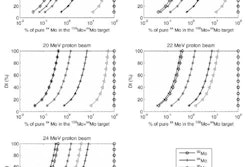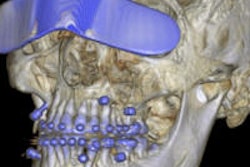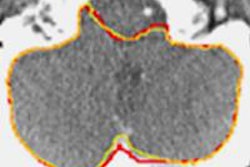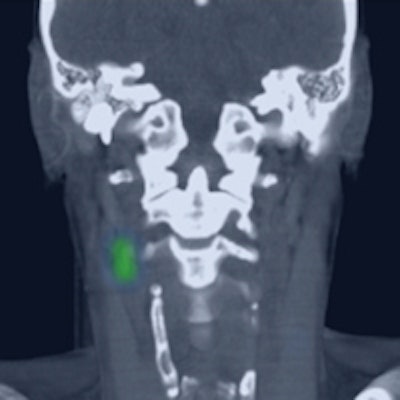
With the help of a novel radiotracer, researchers were able to accurately identify sentinel lymph nodes in patients with head and neck squamous cell carcinoma (HNSCC), potentially reducing the number of patients who need to undergo selective neck dissection.
Results from the international, multicenter trial were presented at this week's International Conference on Innovative Approaches in Head and Neck Oncology (ICHNO) in Nice, France. The study was sponsored by radiopharmaceutical developer Navidea Biopharmaceuticals, which developed the radiotracer technetium-99m (Tc-99m) tilmanocept and markets it as Lymphoseek.
Detecting the HNSCC sentinel node in patients is challenging because there are as many as 150 different lymph nodes in the neck, making the differentiation of true sentinel nodes from secondary ones difficult.
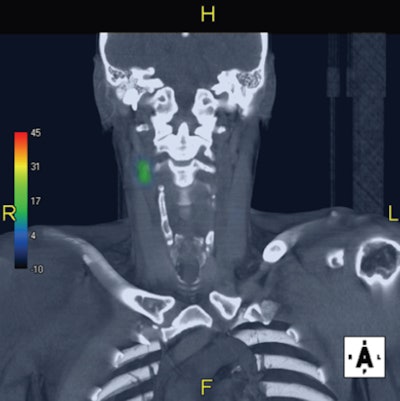 Image of a sentinel node in the neck after injection of Tc-99m tilmanocept. Image courtesy of Dr. Remco de Bree.
Image of a sentinel node in the neck after injection of Tc-99m tilmanocept. Image courtesy of Dr. Remco de Bree.In the past, surgeons have had few options other than to remove all the soft tissue in a lymph node region. Even with selective node dissection, in which fewer nodes are removed, there can be significant side effects such as nerve damage or numbness.
The multicenter trial, led by Dr. Remco de Bree from VU University Medical Center in Amsterdam, was performed at 12 centers in the U.S. The U.S. facilities evaluated 83 patients with early-stage HNSCC, who were injected with Tc-99m tilmanocept and underwent elective neck dissection.
At least one sentinel lymph node was identified and removed in 81 patients, for a detection rate of 97.6%. In addition, the false-negative rate was 2.56%, negative predictive value was 97.8%, sensitivity was 97.4%, and overall accuracy was 98.8%. Tc-99m tilmanocept was well-tolerated in the patient cohort.
The researchers also found that Tc-99m tilmanocept was retained by the sentinel node for up to 30 hours and cleared quickly from the injection site. They speculated that the tracer might be particularly helpful when the injection site is very close to the sentinel node, and also in other tumor locations.
"The data support that in patients with head and neck cancer, Tc-99m tilmanocept-guided pre- and intraoperative sentinel lymph node detection may considerably reduce the number of patients that require elective neck dissection, allowing a substantial reduction in trauma with subsequent morbidity and disfigurement," the authors wrote in their study abstract.
The researchers plan to begin a study in the European Union in which patients will undergo sentinel node mapping after injection of Tc-99m tilmanocept and a conventional radiocolloid tracer.
If the lymphoscintigraphy results with Tc-99m tilmanocept are as good as with the radiocolloid tracer for identifying and detecting sentinel nodes, de Bree and colleagues would like to see a randomized clinical trial involving large numbers of patients.





